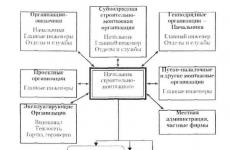Calculation of heat loss of a private house. Heat loss at home - where does the heat really go. The surface of the building envelope
Energy-efficient renovation of the building will save thermal energy and improve the comfort of life. The greatest savings potential lies in the good thermal insulation of the outer walls and roof. The easiest way to assess the possibility of effective repair is the consumption of thermal energy. If more than 100 kWh of electricity (10 m³ natural gas) on the square meter heated area, including wall area, then energy-saving renovations can be beneficial.
Heat loss through the outer shell
The basic concept of an energy-saving building is a continuous layer of thermal insulation over the heated surface of the house contour.
- Roof. With a thick layer of thermal insulation, heat loss through the roof can be reduced;
Important! V wooden structures the thermal insulation of the roof is difficult, as the wood swells and can be damaged by high humidity.
- Walls. As with a roof, heat loss is reduced by the use of a special coating. When internal thermal insulation walls there is a risk that condensate will collect behind the insulation if the humidity in the room is too high;

- Floor or basement. For practical reasons thermal insulation produced from inside the building;
- thermal bridges. Thermal bridges are unwanted cooling fins (heat conductors) on the outside of a building. For example, a concrete floor, which is also a balcony floor. Many thermal bridges are found in soil areas, parapets, window and door frames. There are also temporary thermal bridges if wall parts are fixed with metal elements. Thermal bridges can account for a significant portion of heat loss;
- Window. Over the past 15 years, thermal insulation window glass improved 3 times. Today's windows have a special reflective layer on the glass, which reduces radiation losses, these are single- and double-glazed windows;
- Ventilation. A typical building has air leaks, especially around windows, doors and on the roof, which provides the necessary air exchange. However, during the cold season, this causes significant heat loss from the house from the outgoing heated air. Good modern buildings are sufficiently airtight, and it is necessary to regularly ventilate the premises by opening windows for a few minutes. To reduce heat loss through ventilation, comfort panels are increasingly being installed. ventilation systems. This type of heat loss is estimated at 10-40%.
Thermographic surveys in a poorly insulated building give an idea of how much heat is being wasted. This is very good tool for quality control of repair or new construction.

Ways to assess heat loss at home
There are complex calculation methods that take into account various physical processes: convection exchange, radiation, but they are often redundant. Simplified formulas are usually used, and if necessary, 1-5% can be added to the result. The orientation of the building is taken into account in new buildings, but solar radiation also does not significantly affect the calculation of heat losses.
Important! When applying formulas for calculating heat losses, the time spent by people in a particular room is always taken into account. The smaller it is, the lower temperature indicators should be taken as a basis.
- Average values. The most approximate method does not have sufficient accuracy. There are tables compiled for individual regions, taking into account climatic conditions and average building parameters. For example, for a specific area, the power value in kilowatts is indicated, which is required to heat 10 m² of room area with 3 m high ceilings and one window. If the ceilings are lower or higher, and there are 2 windows in the room, the power indicators are adjusted. This method does not take into account the degree of thermal insulation of the house at all and will not save thermal energy;
- Calculation of heat loss of the enclosing contour of the building. Summarized area external walls minus the dimensions of the areas of windows and doors. Additionally, there is a roof area with a floor. Further calculations are carried out according to the formula:
Q = S x ΔT/R, where:
- S is the found area;
- ΔT is the difference between indoor and outdoor temperatures;
- R is the resistance to heat transfer.
The result obtained for the walls, floor and roof is combined. Then ventilation losses are added.
Important! Such a calculation of heat losses will help determine the boiler capacity for the building, but will not allow you to calculate the number of radiators per room.
- Calculation of heat loss by rooms. When using a similar formula, losses are calculated for all rooms of the building separately. Then, heat losses for ventilation are found by determining the volume of air mass and the approximate number of times a day it is changed in the room.
Important! When calculating ventilation losses, it is necessary to take into account the purpose of the room. The kitchen and bathroom need enhanced ventilation.
An example of calculating the heat loss of a residential building
The second calculation method is used, only for the external structures of the house. Through them, up to 90 percent of thermal energy is lost. Accurate results are important to select the right boiler for output. effective heat without excessive heating of the premises. It is also an indicator economic efficiency selected materials for thermal protection, showing how quickly you can recoup the cost of their purchase. The calculations are simplified, for a building without a multilayer thermal insulation layer.
The house has an area of 10 x 12 m and a height of 6 m. The walls are 2.5 bricks (67 cm) thick, covered with plaster, with a layer of 3 cm. The house has 10 windows 0.9 x 1 m and a door 1 x 2 m.
Calculation of resistance to heat transfer of walls:
- R = n/λ, where:
- n - wall thickness,
- λ is the specific thermal conductivity (W/(m °C).
This value is looked up in the table for its material.

- For brick:
Rkir \u003d 0.67 / 0.38 \u003d 1.76 sq.m ° C / W.
- For plaster coating:
Rpcs \u003d 0.03 / 0.35 \u003d 0.086 sq.m ° C / W;
- Total value:
Rst \u003d Rkir + Rsht \u003d 1.76 + 0.086 \u003d 1.846 sq.m ° C / W;
Calculation of the area of external walls:
- Total area of external walls:
S = (10 + 12) x 2 x 6 = 264 sq.m.
- Area of windows and doorway:
S1 \u003d ((0.9 x 1) x 10) + (1 x 2) \u003d 11 sq.m.
- Adjusted wall area:
S2 = S - S1 = 264 - 11 = 253 sq.m.
Heat losses for walls will be determined by:
Q \u003d S x ΔT / R \u003d 253 x 40 / 1.846 \u003d 6810.22 W.

Important! The value of ΔT is taken arbitrarily. For each region in the tables, you can find the average value of this value.
At the next stage, heat losses through the foundation, windows, roof, and door are calculated in an identical way. When calculating the heat loss index for the foundation, a smaller temperature difference is taken. Then you need to sum up all the received numbers and get the final one.
To determine the possible consumption of electricity for heating, you can represent this figure in kWh and calculate it for heating season.
If you use only the number for the walls, it turns out:
- per day:
6810.22 x 24 = 163.4 kWh;
- per month:
163.4 x 30 = 4903.4 kWh;
- for the heating season of 7 months:
4903.4 x 7 \u003d 34,323.5 kWh.
When the heating is gas, the gas consumption is determined based on its calorific value and the efficiency of the boiler.
Heat losses for ventilation
- Find the air volume of the house:
10 x 12 x 6 = 720 m³;
- The mass of air is found by the formula:
M = ρ x V, where ρ is the air density (taken from the table).
M \u003d 1, 205 x 720 \u003d 867.4 kg.
- It is necessary to determine the figure, how many times the air in the whole house is replaced per day (for example, 6 times), and calculate the heat loss for ventilation:
Qв \u003d nxΔT xmx С, where С is specific heat for air, n is the number of times the air is replaced.
Qv \u003d 6 x 40 x 867.4 x 1.005 \u003d 209217 kJ;
- Now we need to convert to kWh. Since there are 3600 kilojoules in one kilowatt-hour, then 209217 kJ = 58.11 kWh
Some calculation methods suggest taking heat losses for ventilation from 10 to 40 percent of the total heat losses, without calculating them using formulas.
To facilitate the calculation of heat loss at home, there are online calculators where you can calculate the result for each room or the entire house. You simply enter your data in the proposed fields.
Video
Reinforced concrete Concrete on gravel or crushed stone from natural stone Dense silicate concrete Expanded clay concrete on expanded clay. sand and expanded clay foam concrete Р=1800 Expanded clay concrete on expanded clay. sand and expanded clay foam concrete Р=1600 Expanded clay concrete on expanded clay. sand and expanded clay foam concrete Р=1400 Expanded clay concrete on expanded clay. sand and expanded clay foam concrete Р=1200 Expanded clay concrete on expanded clay. sand and expanded clay foam concrete P=1000 Expanded clay concrete on expanded clay. sand and expanded clay foam concrete Р=800 Expanded clay concrete on expanded clay. sand and expanded clay foam concrete Р=600 Expanded clay concrete on expanded clay. sand and expanded clay foam concrete P=500 Expanded clay concrete on quartz sand with porization Р=1200 Expanded clay concrete on quartz sand with porization Р=1000 Expanded clay concrete on quartz sand with porization Р=800 Perlite concrete Р=1200 Perlite concrete Р=1000 Perlite concrete Р=800 Perlite concrete Р=600 Aggloporite concrete and concretes on fuel slag Р=1800 Aggloporite concrete and concrete on fuel slag P=1600 Aggloporite concrete and concrete on fuel slag Р=1400 Aggloporite concrete and concrete on fuel slag Р=1200 Aggloporite concrete and concrete on fuel slag Р=1000 Concrete on ash gravel Р=1400 Concrete on ash gravel Р=1200 Concrete on ash gravel Р=1000 Polystyrene concrete Р=600 Polystyrene concrete Р=500 Gas and foam concrete. gas and foam silicate Р=1000 Gas and foam concrete. gas and foam silicate Р=900 Gas and foam concrete. gas and foam silicate Р=800 Gas and foam concrete. gas and foam silicate Р=700 Gas and foam concrete. gas and foam silicate Р=600 Gas and foam concrete. gas and foam silicate Р=500 Gas and foam concrete. gas and foam silicate Р=400 Gas and foam concrete. gas and foam silicate Р=300 Gas and foam ash concrete Р=1200 Gas and foam ash concrete Р=100 Gas and foam ash concrete Р=800 Cement-sand mortar Complex (sand, lime, cement) mortar Lime-sand mortar Cement-slag mortar P=1400 Cement-slag mortar P=1200 Cement-perlite mortar P=1000 Cement-perlite mortar P=800 Gypsum-perlite mortar Porous gypsum-perlite mortar P=500 Porous gypsum-perlite mortar P=400 Gypsum boards P=1200 Gypsum boards P=1000 Gypsum sheathing sheets (dry plaster) Ordinary clay brick Sand-lime brick P=2000 Sand-lime brick P=1900 Sand-lime brick P=1800 Sand-lime brick P=1700 Sand-lime brick P =1600 ceramic brick Р=1600 Ceramic brick Р=1400 Ceramic stone Р=1700 Thickened silicate brick Р=1600 Thickened silicate brick Р=1400 Silicate stone Р=1400 Silicate stone Р=1300 Granite. gneiss and basalt Marble Limestone P=2000 Limestone P=1800 Limestone P=1600 Limestone P=1400 Tuff P=2000 Tuff P=1800 Tuff P=1600 Tuff P=1400 Tuff P=1200 Tuff P=1000 Pine and spruce across the grain Pine and spruce along the fibers Oak across the fibers Oak along the fibers Glued plywood Facing cardboard Building multi-layer cardboard Wood fiber boards. and wood chip., skopodrevovovolok. Р=1000 Wood fiber boards. and wood chip., skopodrevovovolok. Р=800 Wood fiber boards. and wood chip., skopodrevovovolok. Р=400 Wood fiber boards. and wood chip., skopodrevovovolok. P=200 Fibrolite slabs and arbolite on Portland cement P=800 Fibrolite slabs and arbolite on Portland cement P=600 Fibrolite slabs and arbolite on Portland cement P=400 Fibrolite slabs and arbolite on Portland cement P=300 Fibrous heat-insulating slabs from faux fur waste P=175 Plates Fibrous heat-insulating boards from artificial fur waste Р=150 Fibrous heat-insulating boards from artificial fur waste Р=125 Flax-boned insulating boards Peat heat-insulating boards Р=300 Peat heat-insulating boards Р=200 Tow Mineral wool mats, stitched Р=125 Mineral wool stitched mats Р=100 Mineral wool stitched mats R=75 Mineral wool pierced mats R=50 Mineral wool slabs on a synthetic binder R=250 Mineral wool slabs on a synthetic binder R=200 Mineral wool slabs on a synthetic binder R=175 Mineral wool slabs on a synthetic binder R=125 Mineral wool slabs on a synthetic binder R=75 Plates ne polystyrene boards P=50 Expanded polystyrene boards Р=35 Expanded polystyrene boards Р=25 Expanded polystyrene boards Р=15 Polyurethane foam Р=80 Polyurethane foam Р=60 Polyurethane foam Р=40 Plates from resole-phenol-formaldehyde foam plastic Р=100 Plates from resol-phenol-formaldehyde foam plastic Р=75 Plates from resol-phenol-formaldehyde foam plastic Р =50 Slabs of resolnophenol-formaldehyde foam P=40 Polystyrene-concrete heat-insulating slabs P=300 Polystyrene-concrete heat-insulating slabs P=260 Polystyrene-concrete heat-insulating slabs P=230 Expanded clay gravel P=800 Expanded clay gravel P=600 Expanded clay gravel P=400 Expanded clay gravel P=30 =200 Crushed stone and sand from expanded perlite P=600 Crushed stone and sand from expanded perlite P=400 Crushed stone and sand from expanded perlite P=200 Sand for construction works Foam glass and gas glass Р=200 Foam glass and gas glass Р=180 Foam glass and gas glass Р=160 Flat asbestos-cement sheets Р=1800 Flat asbestos-cement sheets Р=1600 Petroleum construction and roofing bitumen Р=1400 Petroleum construction and roofing bitumen Р=1200 Petroleum construction bitumen and roofing P=1000 Asphalt concrete Products from expanded perlite on a bituminous binder P=400 Products from expanded perlite on a bitumen binder P=300 Roofing material. glassine. roofing Polyvinylchloride multilayer linoleum Р=1800 Polyvinylchloride multilayer linoleum Р=1600 Polyvinylchloride linoleum on fabric substrate Р=1800 Polyvinylchloride linoleum on fabric substrate Р=1600 Polyvinylchloride linoleum on fabric substrate Р=1400 Rebar steel Cast iron Aluminum Copper Window glass
Before you start building a house, you need to buy a house project - that's what the architects say. It is necessary to buy the services of professionals - so the builders say. You need to buy quality Construction Materials- so say the sellers and manufacturers of building materials and insulation.
And you know, in some ways they are all a little bit right. However, no one but you will be so interested in your housing to take into account all the points and bring together all the issues of its construction.
One of the most important issues that should be resolved at the stage is the heat loss of the house. The design of the house, its construction, and what building materials and insulation you will purchase will depend on the calculation of heat loss.
There are no houses with zero heat loss. To do this, the house would have to float in a vacuum with walls 100 meters high. effective insulation. We do not live in a vacuum, and we do not want to invest in 100 meters of insulation. So, our house will have heat loss. Let them be, as long as they are reasonable.
Heat loss through walls
Heat loss through the walls - all the owners think about it at once. The thermal resistance of the building envelope is considered, they are insulated until the standard indicator R is reached, and this completes their work on the insulation of the house. Of course, heat loss through the walls of the house must be considered - the walls have the maximum area of all the enclosing structures of the house. But they are not the only way for heat to get out.

Home insulation is the only way to reduce heat loss through the walls.
In order to limit heat loss through the walls, it is enough to insulate the house 150 mm for the European part of Russia or 200-250 mm of the same insulation for Siberia and the northern regions. And on this you can leave this indicator alone and move on to others, no less important.
Floor heat loss
The cold floor in the house is a disaster. The heat loss of the floor, relative to the same indicator for walls, is about 1.5 times more important. And it is exactly the same amount that the thickness of the insulation in the floor should be greater than the thickness of the insulation in the walls.
Floor heat loss becomes significant when you have a cold basement or just outside air under the floor of the first floor, for example, with screw piles.

Insulate the walls and insulate the floor.
If you lay 200 mm into the walls basalt wool or polystyrene, then you will have to lay 300 millimeters of equally effective insulation in the floor. Only in this case it will be possible to walk barefoot on the floor of the first floor to any, even the most fierce,.
If you have a heated basement under the floor of the first floor or a well-insulated basement with a well-insulated wide blind area, then the insulation of the floor of the first floor can be neglected.
Moreover, it is worth pumping heated air into such a basement or basement from the first floor, and preferably from the second. But the walls of the basement, its slab should be insulated as much as possible so as not to "heat" the ground. Certainly, constant temperature soil + 4C, but this is at a depth. And in winter, around the walls of the basement are the same -30C, as well as on the surface of the soil.
Heat loss through the ceiling
All heat goes up. And there it seeks to go outside, that is, to leave the room. Heat loss through the ceiling in your house is one of the largest values that characterizes the heat loss to the street.
The thickness of the insulation on the ceiling should be 2 times the thickness of the insulation in the walls. Mount 200 mm into walls - mount 400 mm into the ceiling. In this case, you will be guaranteed the maximum thermal resistance of your thermal circuit.

What do we get? Walls 200 mm, floor 300 mm, ceiling 400 mm. Consider that you will save money with which you will heat your home.
Windows heat loss
What is completely impossible to insulate are the windows. Window heat loss is the largest measure of the amount of heat leaving your home. Whatever you make your double-glazed windows - two-chamber, three-chamber or five-chamber, the heat loss of windows will still be gigantic.
How to reduce heat loss through windows? First, it is worth reducing the area of glazing throughout the house. Of course, with large glazing, the house looks chic, and its facade reminds you of France or California. But there is already one thing - either half-wall stained-glass windows or good heat resistance of your house.

If you want to reduce the heat loss of windows, do not plan a large area of them.
Secondly, it should be well insulated window slopes- places where the bindings adhere to the walls.
And, thirdly, it is worth using novelties in the construction industry for additional heat conservation. For example, automatic night heat-saving shutters. Or films that reflect heat radiation back into the house, but freely transmit the visible spectrum.
Where does the heat from the house go?
The walls are insulated, the ceiling and the floor too, the shutters are put on five-chamber double-glazed windows, with might and main it is fired up. But the house is still cold. Where does the heat from the house continue to go?
It's time to look for cracks, cracks and cracks, where the heat leaves the house.
First, the ventilation system. Cold air comes in supply ventilation into the house, warm air leaves the house exhaust ventilation. To reduce heat loss through ventilation, you can install a heat exchanger - a heat exchanger that takes heat from the outgoing warm air and heating the incoming cold air.

One way to reduce heat loss at home through the ventilation system is to install a heat exchanger.
Secondly, the entrance doors. To exclude heat loss through the doors, a cold vestibule should be mounted, which will be a buffer between entrance doors and outdoor air. The tambour should be relatively airtight and unheated.
Thirdly, it is worth at least once to look at your house in the cold with a thermal imager. Departure of experts costs not so big money. But you will have a “map of facades and ceilings” on hand, and you will clearly know what other measures to take in order to reduce heat loss at home during the cold season.
The calculation of the heating of a private house can be done independently by taking some measurements and substituting your values into the necessary formulas. Let's tell you how it's done.
We calculate the heat loss of the house
Several critical parameters of the heating system depend on the calculation of heat loss at home, and first of all, the power of the boiler.
The calculation sequence is as follows:
We calculate and write down in a column the area of windows, doors, external walls, floors, ceilings of each room. Opposite each value we write down the coefficient from which our house is built.
If you didn't find desired material in, then look in the extended version of the table, which is called so - the coefficients of thermal conductivity of materials (soon on our website). Further, according to the formula below, we calculate the heat loss of each structural element of our house.
Q=S*ΔT/R,where Q– heat loss, W
S— construction area, m2
Δ T— temperature difference between indoors and outdoors for the coldest days °C
R— the value of thermal resistance of the structure, m2 °C/W
R layer = V / λwhere V— layer thickness in m,
λ - coefficient of thermal conductivity (see table for materials).
We summarize the thermal resistance of all layers. Those. for walls, both plaster and wall material and external insulation (if any) are taken into account.
Putting it all together Q for windows, doors, exterior walls, floors, ceilings
We add 10-40% of ventilation losses to the amount received. They can also be calculated by the formula, but with good windows and moderate ventilation, you can safely set 10%.
We divide the result by total area Houses. It is the general, because heat will indirectly be spent on corridors where there are no radiators. The calculated value of specific heat loss can vary within 50-150 W/m2. The highest heat losses are in the rooms of the upper floors, the lowest in the middle ones.
After graduation installation work, conduct walls, ceilings and other structural elements to make sure that there are no heat leaks anywhere.
The table below will help you more accurately determine the indicators of materials.

Determining the temperature
This stage is directly related to the choice of the boiler and the method of space heating. If it is planned to install "warm floors", it is possible the best solution– condensing boiler and low temperature regime 55C in the supply and 45C in the "return". This mode ensures the maximum efficiency of the boiler and, accordingly, the best gas savings. In the future, if you want to use high-tech heating methods, ( , solar collectors) you do not have to remake the heating system for new equipment, because It is designed specifically for low temperatures. Additional pluses - the air in the room does not dry out, the flow rate is lower, less dust is collected.
In the case of choosing a traditional boiler, it is better to choose the temperature regime as close as possible to European standards 75C - at the outlet of the boiler, 65C - return flow, 20C - room temperature. This mode is provided in the settings of almost all imported boilers. In addition to choosing a boiler, the temperature regime affects the calculation of the power of radiators.
Selection of power radiators
 For the calculation of heating radiators for a private house, the material of the product does not play a role. This is a matter of taste of the owner of the house. Only the power of the radiator indicated in the product passport is important. Often manufacturers indicate inflated figures, so the result of the calculations will be rounded up. The calculation is made for each room separately. Simplifying somewhat the calculations for a room with ceilings of 2.7 m, we present a simple formula:
For the calculation of heating radiators for a private house, the material of the product does not play a role. This is a matter of taste of the owner of the house. Only the power of the radiator indicated in the product passport is important. Often manufacturers indicate inflated figures, so the result of the calculations will be rounded up. The calculation is made for each room separately. Simplifying somewhat the calculations for a room with ceilings of 2.7 m, we present a simple formula:
Where TO- desired number of radiator sections
S- area of the room
P- power indicated in the product passport
Calculation example: For a room with an area of 30 m2 and a power of one section of 180 W, we get: K = 30 x 100/180
K=16.67 rounded 17 sections
The same calculation can be applied to cast iron batteries, assuming that
1 rib(60 cm) = 1 section.
Hydraulic calculation of the heating system
The meaning of this calculation is to choose the right pipe diameter and characteristics. Due to the complexity of the calculation formulas, it is easier for a private house to select pipe parameters from the table.
Here is the total power of the radiators for which the pipe supplies heat.
| Pipe diameter | Min. radiator power kW | Max. radiator power kW |
| Metal-plastic pipe 16 mm | 2,8 | 4,5 |
| Metal-plastic pipe 20 mm | 5 | 8 |
| Metal-plastic pipe 25 mm | 8 | 13 |
| Metal-plastic pipe 32 mm | 13 | 21 |
| Polypropylene pipe 20 mm | 4 | 7 |
| Polypropylene pipe 25 mm | 6 | 11 |
| Polypropylene pipe 32 mm | 10 | 18 |
| Polypropylene pipe 40 mm | 16 | 28 |
We calculate the volume of the heating system
This value is necessary to select the correct volume expansion tank. It is calculated as the sum of the volumes in the radiators, pipelines and boiler. Reference information on radiators and pipelines is given below, on the boiler - indicated in its passport.
The volume of coolant in the radiator:
- aluminum section - 0.450 liters
- bimetallic section - 0.250 liters
- new cast iron section - 1,000 liters
- old cast iron section - 1,700 liters
The volume of the coolant in 1 l.m. pipes:
- ø15 (G ½") - 0.177 liters
- ø20 (G ¾") - 0.310 liters
- ø25 (G 1.0″) - 0.490 liters
- ø32 (G 1¼") - 0.800 liters
- ø15 (G 1½") - 1.250 liters
- ø15 (G 2.0″) - 1.960 liters
Installation of the heating system of a private house - the choice of pipes
It is carried out with pipes from different materials:
Steel
- They have a lot of weight.
- They require proper skill, special tools and equipment for installation.
- Corrosion resistant
- May accumulate static electricity.
Copper
- Withstand temperatures up to 2000 C, pressure up to 200 atm. (in a private house, completely unnecessary dignity)
- Reliable and durable
- Have a high cost
- Mounted with special equipment, silver solder
Plastic
- Antistatic
- Corrosion resistant
- Inexpensive
- Have minimal hydraulic resistance
- Requires no special skills for installation
Summarize
Correctly made calculation of the heating system of a private house provides:
- Comfortable warmth in the rooms.
- Sufficient amount of hot water.
- Silence in the pipes (no gurgling or growling).
- Optimal boiler operating modes
- Correct load on the circulation pump.
- Minimum installation costs
Not all materials that are used in construction are able to provide the proper level of heat saving for a private house. Through the walls, roof, floor, window openings there is a constant leakage of heat. Having determined with the help of a thermal imager which structural elements of the building act as “weak links”, it is possible to significantly reduce heat loss in a private house by means of complex or fragmentary insulation.
Insulate windows
Insulation of windows at home is most often performed according to Swedish technology, for which everything window sashes removed from the frames, then along the perimeter of the frame, a groove is selected with a cutter, into which a tubular sealant made of silicone (with a diameter of 2 to 7 mm) is filled - this allows you to reliably seal the window porches. Small gaps in the frames, the gaps between the double-glazed window and the frame are filled with sealant after preliminary washing, cleaning and drying the windows.

Window insulation can also be performed using a heat-saving film, which is fixed to the window with a self-adhesive strip. window frame. Letting light into the room, the film reliably shields heat flows due to metallized sputtering, returning about 60% of heat back into the room. Significant heat losses through windows are often associated with a violation of the geometry of the frame, gaps between the frame and slopes, sagging and skewed sashes, poor functioning of fittings - to eliminate these problems, qualified adjustment or repair of windows is required.
Insulate the walls
The most significant heat loss - about 40%, occurs through the walls of buildings, so thoughtful insulation capital walls of a private house will radically improve its heat-saving parameters. Wall insulation can be done from the inside or/and outside - the method of insulation depends on the material used in the construction of the house. brick and foam concrete houses most often they are insulated from the outside, but a heat insulator can also be laid from the inside of these buildings. Wooden houses almost never insulated from the side interior spaces, to avoid the greenhouse effect in the rooms. Outside, houses are insulated from a bar, sometimes from a log house.

Insulation of the walls of the house can be performed using the "wet" or "wet" technology. hinged facade- the main difference between these methods lies in the principle of installation facade cladding. When arranging a “wet” facade, a dense heat insulator (polystyrene foam, polystyrene foam) is attached to the wall, and then decorative trim using adhesives. When installing a hinged facade, after installing a heater (mineral or glass wool), a crate is mounted, and then facing modules are fixed in its profiles. Mandatory element The "pie" of the walls is a vapor barrier film, which removes condensate from the insulation layer, protects it from getting wet and prevents the loss of insulating properties.
Insulate the roof
The roof of the house is another surface through which heat constantly escapes from the house. Depending on the material used in the arrangement roof deck, the roof can be more or less warm. Capital insulation, as a rule, require metal roofs from corrugated board and metal tiles. Roofs made of ondulin, flexible and ceramic tiles have low thermal conductivity, so for them the insulating "pie" can be thinner than in the case of metal. Similar to the technology for insulating other surfaces of the house, a vapor barrier must be included in the “pie” of the roof, and one or two ventilation gaps are provided for effective ventilation of the under-roof space.

Insulate the floor
Unlike walls and window openings, heat leakage through the floor of a private house is small - approximately 10%, and subject to the arrangement of insulation, it will be reduced to a minimum. As a heater for floors, the same polystyrene, polystyrene or mineral wool, but it is also possible to use expanded clay, foamed concrete, cement-bonded mixtures and peat mats. An additional insulation measure in country house installation of warm floors can act: water, cable or infrared.

Similar to the device for insulating walls and roofs, an obligatory component of the "pie" of the floor is vapor barrier membrane, which shields moisture-saturated steam seeping from inner space home outside. Thus, the heat-insulating layer is reliably protected from getting wet.






